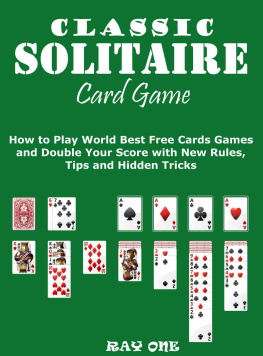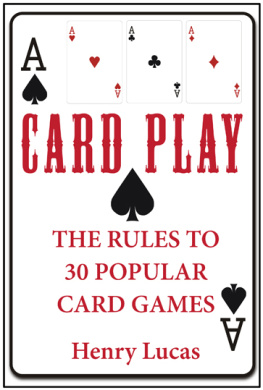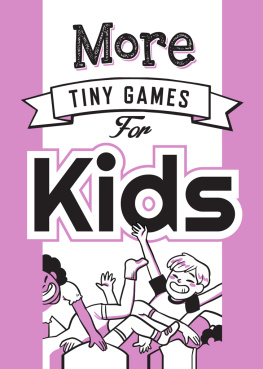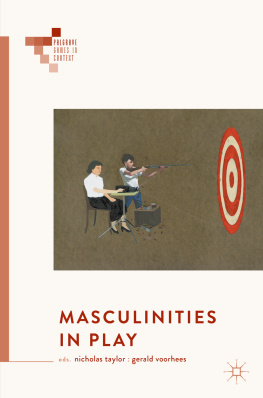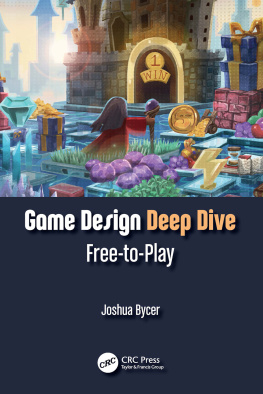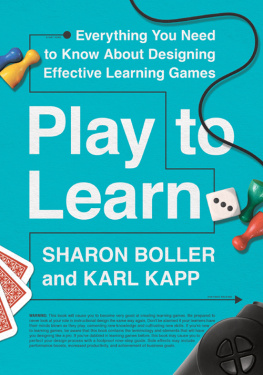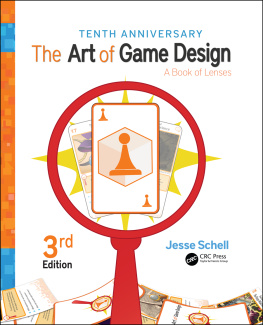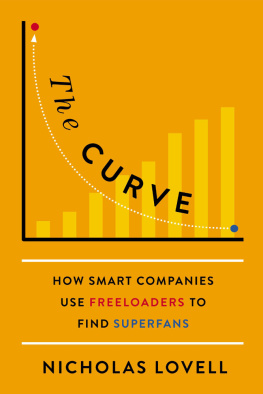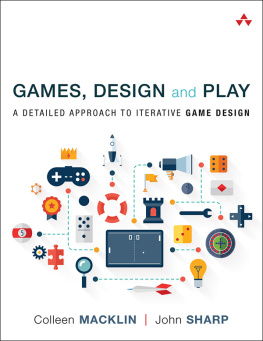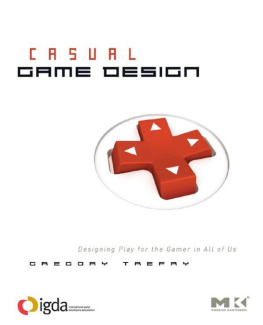Lovell Nicholas - Design Rules for Free-to-Play Games
Here you can read online Lovell Nicholas - Design Rules for Free-to-Play Games full text of the book (entire story) in english for free. Download pdf and epub, get meaning, cover and reviews about this ebook. year: 2012, publisher: GAMESbrief, genre: Romance novel. Description of the work, (preface) as well as reviews are available. Best literature library LitArk.com created for fans of good reading and offers a wide selection of genres:
Romance novel
Science fiction
Adventure
Detective
Science
History
Home and family
Prose
Art
Politics
Computer
Non-fiction
Religion
Business
Children
Humor
Choose a favorite category and find really read worthwhile books. Enjoy immersion in the world of imagination, feel the emotions of the characters or learn something new for yourself, make an fascinating discovery.
- Book:Design Rules for Free-to-Play Games
- Author:
- Publisher:GAMESbrief
- Genre:
- Year:2012
- Rating:5 / 5
- Favourites:Add to favourites
- Your mark:
- 100
- 1
- 2
- 3
- 4
- 5
Design Rules for Free-to-Play Games: summary, description and annotation
We offer to read an annotation, description, summary or preface (depends on what the author of the book "Design Rules for Free-to-Play Games" wrote himself). If you haven't found the necessary information about the book — write in the comments, we will try to find it.
Design Rules for Free-to-Play Games — read online for free the complete book (whole text) full work
Below is the text of the book, divided by pages. System saving the place of the last page read, allows you to conveniently read the book "Design Rules for Free-to-Play Games" online for free, without having to search again every time where you left off. Put a bookmark, and you can go to the page where you finished reading at any time.
Font size:
Interval:
Bookmark:
Design Rules for
Free-to-Play Games
Nicholas Lovell
Rob Fahey
Published by GAMESbrief http://www.gamesbrief.com London, October 2012 |
PART ONE: The Rules
PART TWO: Stuff You Need To Know
Why do we need to define rules for free to play games?
Quite simply, because "free" is a concept thats as scary as it is powerful. Its something were all being forced to get used to. Digital communications have changed our lives in many ways, but for creatives, perhaps the biggest upheaval is that the cost of distributing media - music, books, games, films - has plummeted to the point where its almost zero. The cost and effort involved in creating and transmitting a copy of a piece of work has fallen away; where once there was a huge barrier that customers could be charged to cross, now theres barely a bump on the ground.
Nobody survives long by standing in front of the flood waters demanding that they retreat. You survive - and thrive - by reacting to whats happening and finding the new opportunities created by the changes around you.
Thats what free-to-play is about. Rather than bemoaning the fact that the old model of charging people to access content is in decline, pioneers of free-to-play see the positives of our new situation. We have access to an audience thats bigger than ever before; an audience thats constantly connected, allowing you to see how theyre playing and engage with them throughout the whole play experience. Now that the customer relationship no longer ends at the till of a game store, developers and games can adapt to the audience and treat players as individuals.
Thats extraordinary power, but its still something many creatives and businesspeople alike are getting used to. It requires big changes in how we all think. A decade ago, if 90% of your audience was playing your game for free, it meant you had a piracy problem; today, it means youve got a 10% conversion rate, which is actually pretty good. As if thats not strange enough, even those 10% who are paying are probably paying for relatively simple in-game items and currency, while all the really amazing stuff youve created - your world, your game, your artistry - has been served up to absolutely everyone for free. Its a complete reversal of how game creators have always had to think.
Thats why we need rules for free to play games - because while many of the ideas encoded in these rules may seem straightforward or even over-simplistic, theyre all true, and moving to this model has required us to re-examine many of the most fundamental truths of game development. These rules have crystallised from countless hours of experience of working with some of the best free-to-play developers in the business. They reflect concepts which absolutely everyone working on a free-to-play game should know, understand and consider throughout their thought process.
But arent rules meant to be broken?
Why yes, of course - but thats simply another reason why we need rules. Why is the broken spelling and grammar of a failing English student marked with red pen, while the equally fractured prose of James Joyces Ulysses and Jonathan Safran Foers Everything Is Illuminated are considered to be literary masterpieces? Because the latter two understood the rules they were breaking - in fact, they understood them perhaps far better than the majority of writers, which meant that in breaking them, they achieved a deliberate and knowing effect.
In other words, you dont have to follow the rules - and you can achieve great things by breaking them - but if you dont understand them and make a conscious, informed decision to step outside their boundaries, youre just lashing out in the darkness.
Thats why we need rules, and why we need to understand rules. So we can understand where we are; so we can pass on the experience and knowledge of pioneers in this field to newcomers; and sometimes, so that they can be broken.
GAMESbrief is a blog and resource about the business of games.
Specifically, GAMESbrief is about making sense of the most important and challenging development in the games business - the rise of free, and the new business models it has created. Its about providing developers and publishers with the information, tools and resources they need to take advantage of the opportunities provided by new platforms like the App Store and Facebook, and to avoid the pitfalls along the way.
The site publishes opinion, analysis and information for free-to-play developers and publishers, as well as regular guest posts from industry luminaries exploring their experiences and insights into the market. In addition, we publish lively discussions among the GAMESbriefers - a closed group of top figures from around the free-to-play and social games business who debate a chosen topical issue each week.
Along with this book, GAMESbrief is also the publisher of How To Publish A Game, a practical and comprehensive guide to self-publishing which is essential reading for anyone setting out in this business - or for veterans and established companies looking to make the transition to the industrys new direction. (Theres a in the back of this book, by the way.)
To find out more, visit the site: www.gamesbrief.com
Nicholas Lovell is the founder of GAMESbrief, the author of How To Publish A Game, and an expert consultant on free-to-play businesses who has worked for clients including Square Enix, Channel 4, IPC Media, nDreams, Firefly, Atari, Rebellion and Channelflip. He has written for publications such as Gamasutra, Develop, MCV and the Wall Street Journal, and speaks regularly at development and media conferences. He is also the author of The Curve, an upcoming book about using the web to make money from freeloaders and true fans alike, which will be published by Penguin in early 2013.
Nicholas devised the Free-to-Play Design Rules, based on his extensive experience of working with developers and publishers of free-to-play games.
He lives in London, just close enough to the Thames for him to be able to look wistfully over the water and dream about having time to pursue his passion for sailing.
Rob Fahey is a freelance journalist and consultant who specialises in the business of games. He was the founding editor of GamesIndustry.biz and has written a regular column there for the past decade, as well as working on publications including Eurogamer, VG247, British newspaper of record The Times - and, of course, GAMESbrief. He has often appeared on TV and radio in the UK to discuss the games business.
Rob turned Nicholas Free-to-Play Design Rules into a book, and wrote all the supporting material and explanations.
He lives either in London or in Tokyo, depending on when youre reading this, speaks reasonably good Japanese and thinks that researching Asian politics counts as a fun leisure time activity.
Part One:
The Rules
Before worrying about anything else, worry about making a game thats fun to play.
The first rule of free-to-play is "make the game fun".
It shouldnt need to be stated, but it does.
It is entirely possible to make a game that doesnt focus on the fun and make it a successful free-to-play game. Some of the criticisms levied at the free-to-play industry that it uses , that psychological tricks are not enough to make a game are tied up with this idea that the games arent fun.
Next pageFont size:
Interval:
Bookmark:
Similar books «Design Rules for Free-to-Play Games»
Look at similar books to Design Rules for Free-to-Play Games. We have selected literature similar in name and meaning in the hope of providing readers with more options to find new, interesting, not yet read works.
Discussion, reviews of the book Design Rules for Free-to-Play Games and just readers' own opinions. Leave your comments, write what you think about the work, its meaning or the main characters. Specify what exactly you liked and what you didn't like, and why you think so.


